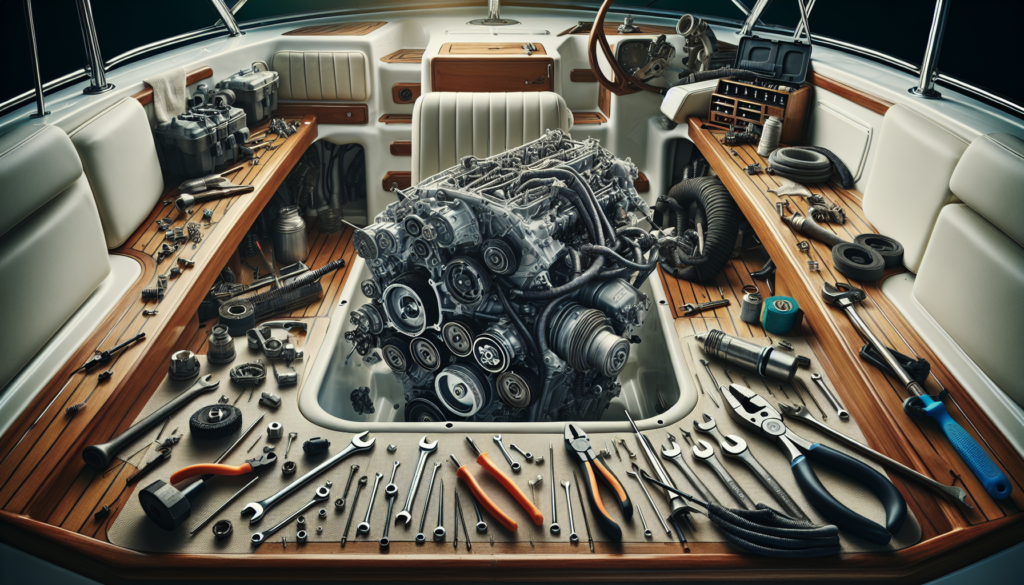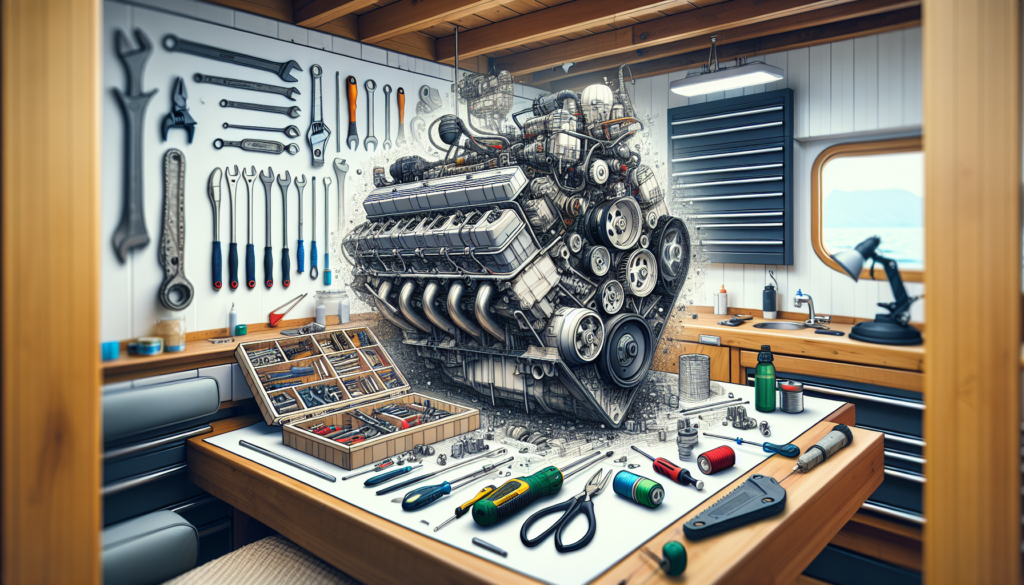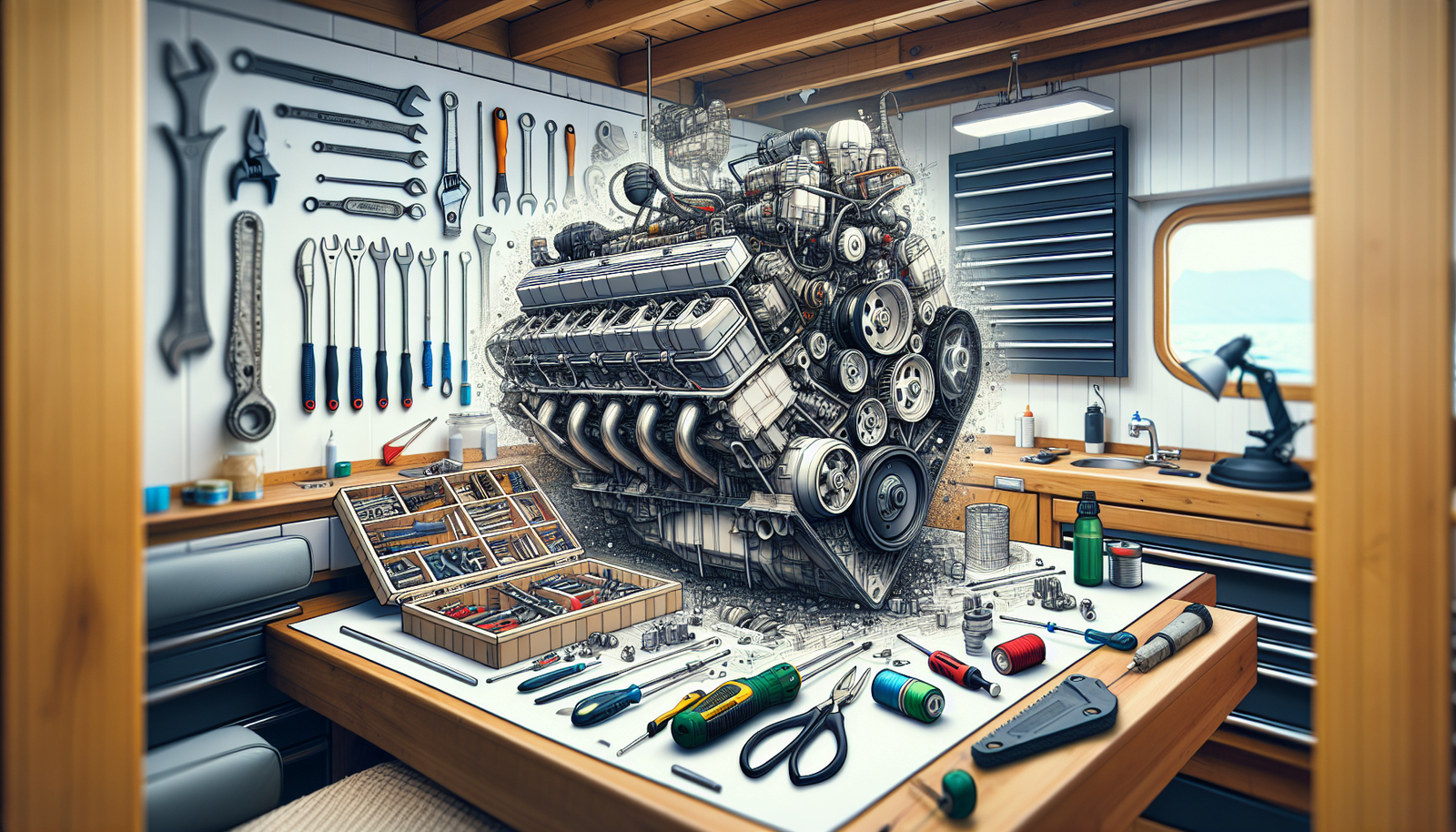Heading out on the water can be a thrilling experience, but there’s no fun in being stranded mid-journey due to an engine failure. “DIY Boat Engine Maintenance Tips for Beginners” is an article crafted just for you, a novice boat owner. It imparts simple but effective guidelines on how you can maintain your boat engine and avoid the engine-related issues that often cut short the joy of boat rides. So while you are excited to dip your oars in the water, take a moment and learn how to keep that engine humming along, ensuring many smooth-sailing adventures ahead.

Identifying Different Types of Boat Engines
Boat engines, similar to car engines, come in a range of styles and complexities, each with its unique characteristics and purpose. It’s a vast sea out there with a variety of boat engines, but for the sake of simplicity, let’s focus on the four most common types.
Outboard Boat Engines
Outboard motors, often referred to as ‘outboards,’ are self-contained engines mounted at the stern (rear) of the boat. Because the engine, gearbox, and propeller are all built into a single portable unit, these tend to be popular choices for smaller boats. You can recognize outboard engines by their easy-to-access location on the back of the boat. They’re ideal for sailing into shallow waters as they can be lifted out of the water to avoid damage.
Inboard Boat Engines
In contrast to outboard engines, inboard engines are mounted inside the boat’s hull with a drive shaft running through the bottom of the boat to the propeller. This style, favoured on larger vessels, allows for more balance and stability due to the weight placement within the boat. Inboard engines tend to require a bit more know-how to maintain but are often chosen for their power and prowess.
Sterndrive Boat Engines
The sterndrive, also known as an “inboard/outboard” engine, offers a bit of both worlds. This hybrid engine is located inside the boat like an inboard engine but has an outdrive unit attached to the stern, like an outboard engine. The major advantage of this system is the balance it brings to the boat, along with improved maneuverability and speed.
Jet Engine Boats
Jet engine boats are a unique breed. Instead of a traditional propeller, jet boats use a pump to suck in water, then blast it out back, propelling the boat forward. Aiding in their popularity is the fact that because they do not have external props, they’re safer for water sports and can traverse shallow waters more easily.
Understanding Basic Boat Engine Anatomy
Just as human anatomy is crucial for physicians, understanding the basic boat engine parts and their functions plays a crucial role in maintaining a boat engine. Let’s dive in and get to know the key players.
Engine Block
Think of the engine block as the skeleton of the engine. It’s the strong and steady part that houses the cylinders and other components of the engine.
Cylinder Head
The cylinder head is located on top of the engine block and forms the top of the combustion chamber. It plays a crucial role in the engine’s cooling system and houses other key parts of the engine such as the spark plugs.
Piston and Connecting Rod
Inside the cylinder, we find the piston. The piston moves up and down within the cylinder, compressing the air-fuel mixture and making the magic of combustion happen. The connecting rod connects the piston to the crankshaft.
Valves and Valve Springs
Then we have the intake and exhaust valves and valve springs. The intake valve allows the air and fuel into the cylinder, and the exhaust valve lets out the exhaust after combustion. The valve springs keep these valves in place.
Crankshaft and Camshaft
Lastly, we have the crankshaft and camshaft. The crankshaft takes the up and down movement of the pistons and turns it into the rotational motion needed to move the boat. The camshaft, on the other hand, opens and closes the intake and exhaust valves at the correct time.
Familiarizing with the Tools Needed for Boat Engine Maintenance
Before you get started tinkering around with your boat engine, immerse yourself in this list of basic tools that are essential for any DIY boat engine maintenance project. As your father probably told you, the right tools can make all the difference!
Screwdrivers Set
A reliable set of screwdrivers is a must-have in any tool kit. Whether you’re removing the engine cover, adjusting the carburetor, or just about any other task, having the right size and type of screwdriver can make your job a breeze.
Adjustable Wrenches
Another common tool you will need is a set of adjustable wrenches with different sizes to handle various jobs. From tightening bolts to loosening nuts, these wrenches come in handy quite often.
Pliers
Pliers are one of those tools you’ll find yourself reaching for quite frequently. Whether it’s to remove a stubborn spark plug or to keep a bolt from spinning while you tighten a nut, having a set of pliers around can be a real time-saver.
Spark Plug Socket
As the name implies, a spark plug socket is a special type of socket designed to remove and install spark plugs. It’s usually rubber-lined to protect the spark plug from damage.
Oil Filter Wrench
The oil filter wrench is designed to remove the oil filter, a task that can be near impossible without it due to the oil filter’s location and how tightly it’s installed.

Inspecting the Boat Engine
When inspecting your boat’s engine, remember to be methodical. Follow a checklist, and you’re less likely to overlook something. Below are the key things to look for when performing an engine inspection.
Performing a Visual Inspection
Start by taking a good look around. Check for cracks on the engine block, corrosion, or any signs of damage. Look for any loose or disconnected wires and hoses.
Checking for Leaks
Check the ground underneath the engine for any pooled fluids or drips. If found, determine whether it’s fuel, oil or coolant, and trace it back to its source.
Checking Engine Oil Level
Oil is critical for your engine’s performance. Always make sure there is an adequate amount and it’s clean. Oil that’s black or gritty should be changed.
Inspecting the Fuel System
Look for any leaks or damage in the fuel line. Check the fuel filter and replace it if it’s clogged or dirty.
Assessing the Electrical System
Having a functional electrical system is vital for marine engines. Check the battery connections and terminals. Inspect the fuses and make sure all components are working properly.
Changing the Engine Oil
Changing your boat’s engine oil is not all that different from changing the oil on your car. It’s an integral maintenance chore that helps extend the life of your engine.
Choosing the Correct Engine Oil
Not just any oil will do. Using the correct oil is paramount for the optimum performance of your boat engine. Refer to your owner’s manual to find the oil grade recommended for your model.
Draining the Old Engine Oil
Once you have your new oil ready to go, it’s time to drain the old stuff. Check your engine manual to find the correct process, as it varies by engine type. Generally, you have a drain plug at the base of the oil pan or a pump to draw out the used oil.
Replacing the Engine Oil Filter
An oil change is a great time to replace your oil filter. Just unscrew the old one, apply a bit of oil to the gasket on the new one, and screw it in place.
Adding New Engine Oil
Lastly, it’s time to add the fresh oil. Again, your engine’s manual will provide the correct amount. Take care not to overfill it.
Maintaining Spark Plugs
Just like in an automobile, the spark plugs in a boat engine play a major role in kick-starting the combustion process.
Understanding the Importance of Spark Plugs
Spark plugs are the tiny but mighty parts of your boat engine that help to ignite the air and fuel mixture in the cylinders. Without them, your boat isn’t going anywhere.
Inspecting the Spark Plugs
Keep an eye out for fouled or worn-out spark plugs. Remove the plugs and look for any signs of wear or damage, like burnt electrodes or deposits on the plug.
Cleaning the Spark Plugs
If the spark plugs are dirty but not damaged, they can often be cleaned using a wire brush or special cleaner. But always remember, the cost of replacing spark plugs is much less than the cost of repairing a damaged engine due to faulty plugs.
Replacing the Spark Plugs if Necessary
If you find your spark plugs are worn or damaged during the inspection, it’s best to replace them. Generally, you should change out the spark plugs every 100 hours of operation or at least once a year.
Fuel System Care
Keeping your marine engine’s fuel system in tip-top shape is important for your engine’s performance.
Checking the Fuel Line
Start by checking the fuel line for any signs of damage, like cracks or leaks. If you discover any, it’s best to replace the line rather than repair it.
Cleaning or Replacing the Fuel Filter
Fuel filters prevent impurities from getting into your engine. Over time, these filters can accumulate dirt, so it’s important to clean or replace them regularly.
Maintaining the Fuel Tank
Inspect your fuel tank for any signs of rust or damage. Always keep it clean to avoid water and contamination that could harm your engine.
Understanding Boat Engine Fuel System Issues
Familiarizing yourself with common boat engine fuel issues, such as water in the fuel, dirty injectors, or stale fuel, can make troubleshooting easier. Usually, a misbehaving engine might be a fuel system in distress.
Keeping the Cooling System in Check
For many boat engines, the cooling system is what keeps it from overheating and causing costly damage.
Understanding the Role of the Cooling System
Most boat engines use water from the surrounding environment to cool the engine. The cooling system pumps this water through the engine block to reduce the heat generated by the engine’s operation.
Inspecting the Coolant Level
It’s crucial to regularly check the coolant level in a closed cooling system. If it’s running low, top it off. This is not for raw-water cooling systems that source their water directly from the underboat environment.
Changing the Coolant
If the existing coolant is dirty, it’s time to change it. Dirty coolant can lead to overheating and other serious engine problems.
Inspecting the Belts and Hoses
Hoses carry coolant to and from the engine block, and belts drive the water pump. Therefore, it’s important to regularly check for any cracks, leaks, or signs of wear in the hoses and belts.
Winterizing Your Boat Engine
As cold weather closes in, taking the time to “winterize” your boat’s engine can save you a lot of hassles in the spring.
Cleaning the Boat Engine
Start by giving your engine a good cleaning. This helps to get rid of any salt, dirt, and grime, which can cause corrosion over time if left unchecked.
Applying a Fogging Oil
Next, spray a fogging oil into the carburetor while the engine is running. This coats the internal components of the engine in a protective film that reduces oxidation over the winter.
Draining the Coolant System
Drain the coolant system thoroughly to avoid freezing, which can cause components to crack.
Filling the Engine Block with Antifreeze
After draining, fill the engine block with antifreeze to protect against freezing and corrosion.
Storing Your Boat Properly
Finally, store your boat properly — ideally in a climate-controlled environment to protect it from harsh weather.
Troubleshooting Common Boat Engine Problems
Every boat owner will face moments when their boat engine behaves strangely. Understanding common boat engine problems can help you troubleshoot and respond effectively.
Stalling Issues
If your boat engine tends to stall, this could be due to dirty filters, low fuel pressure, or issues with the fuel injectors.
Overheating Problems
How would you know if your boat is overheating? A temperature gauge reading above normal, steam, or hot engine surfaces are telltale signs. Causes might be a faulty water pump, blocked coolant passages, a broken belt or a damaged propeller.
Engine Not Starting
If the engine won’t start, it’s usually an issue with the battery, starter motor, or a lack of fuel or spark.
Excessive Smoke from the Exhaust
Heavy, thick smoke from the exhaust suggests trouble. It can signal burnt oil, indicating that your engine may be consuming more oil than normal.
Loud Noises Coming from the Engine
Knocking, rattling, or squealing sounds should not be ignored. They often indicate trouble with the propeller, drive belt, pistons, or other engine components.
Sudden Loss of Power While Running
If your boat suddenly loses power while running, it could be due to a dirty fuel filter, propeller damage, or a malfunctioning spark plug.
Remember that while some boat engine problems can be easily handled by an enthusiastic DIYer, others demand professional attention. So, don’t hesitate to call in the pros when necessary. Ensuring the health of your engine will keep you out on the waters for many years to come!


[…] those weekend getaways remain fun and stress-free. In the following piece, “Essential boat engine maintenance Checklist,” we’re offering you handful tips and guidelines for regular upkeep of your […]